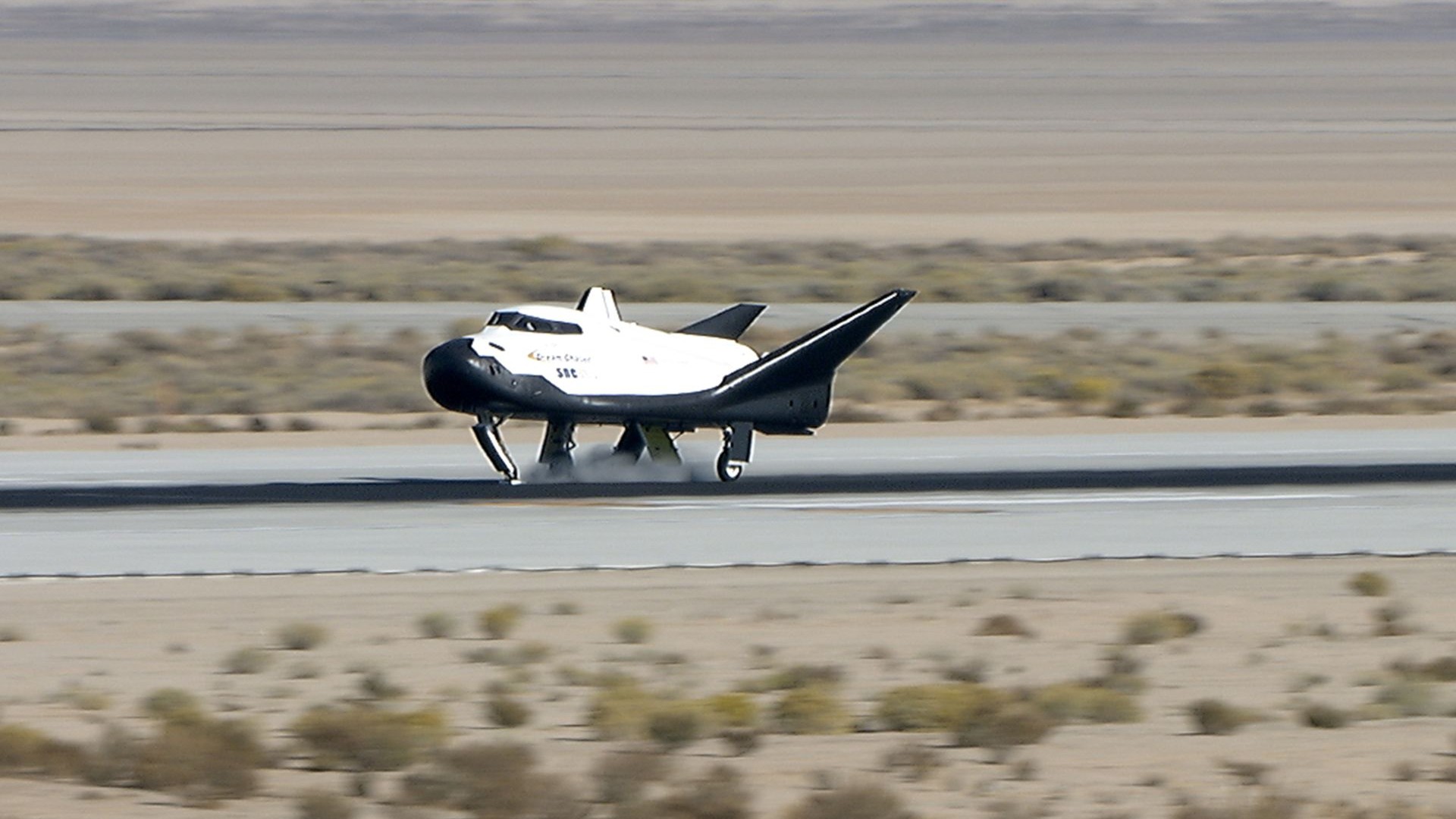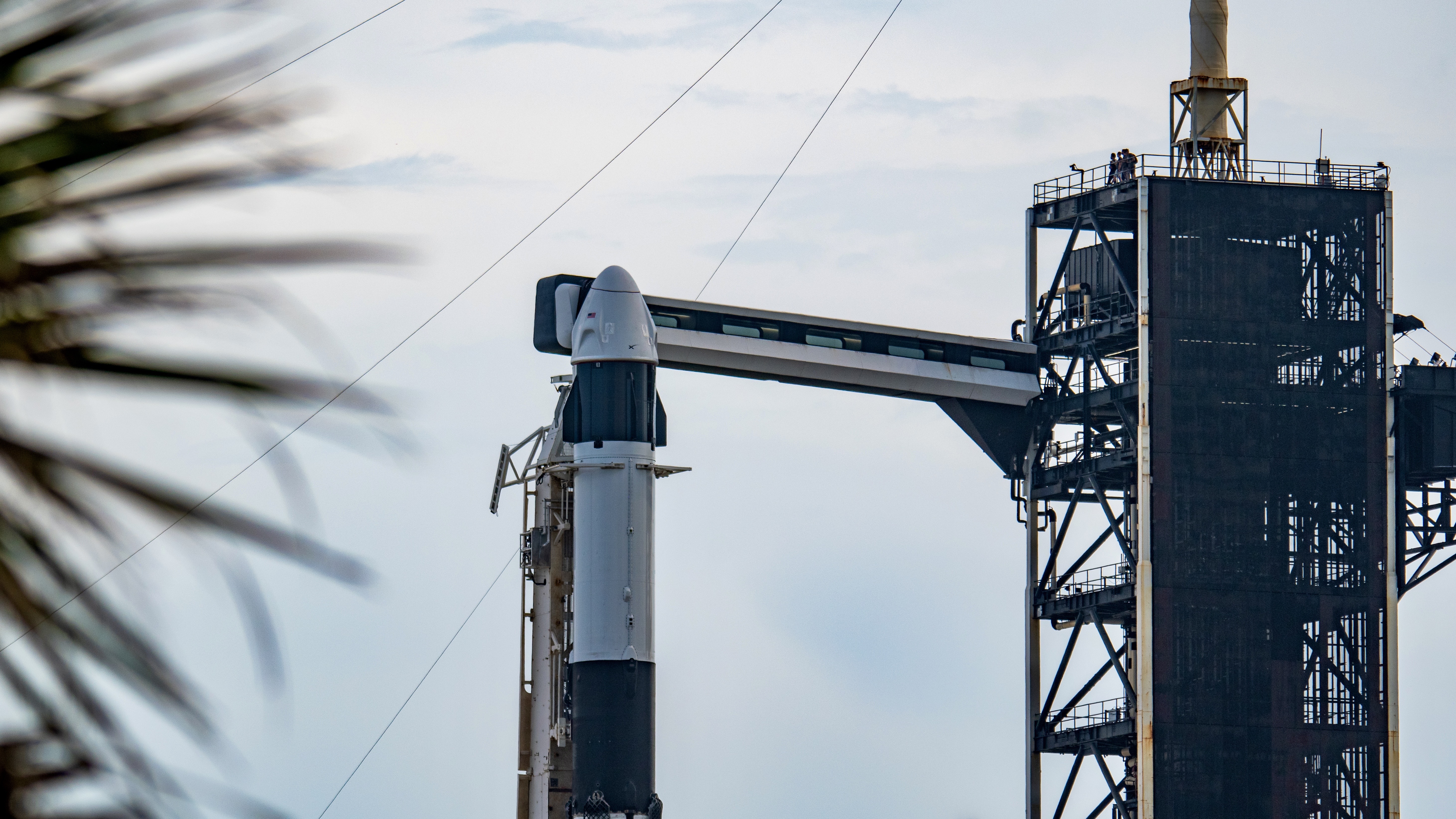Dream Chaser: Sierra Space's design for spaceflight
Dream Chaser is a shuttle-shaped spacecraft that will send cargo to the International Space Station. A crew version of the spacecraft is also available.

Dream Chaser is a private spacecraft from Sierra Space designed to send cargo and astronauts to low Earth orbit.
The cargo version is expected to bring experiments, equipment and other payloads to the International Space Station (ISS) no earlier than December 2023.
For its first launches, Dream Chaser is expected to use the brand-new Vulcan Centaur rocket from United Launch Alliance, pending readiness of that system and of Dream Chaser itself. Regardless of the rocket or mission, however, the shuttle-shaped spacecraft is designed to land on conventional shuttle runways at the end of the flight.
Dream Chaser specifications
- Length: 30 feet (9 meters)
- Cargo capacity: 12,000 pounds (5,443 kilograms), excluding the expendable cargo vehicle, which has 10,000 pounds (4,536 kg) of additional capacity
- Wings: Foldable (cargo version) or non-foldable (crew version)
- Crew capacity: Seven
- Destinations: Low Earth orbit, solo or to space stations
- Launching rocket: Vulcan Centaur, with possible others to come

Dream Chaser design and development
Dream Chaser looks a bit like a stubby version of the space shuttle; it is based on NASA and Soviet designs. Dream Chaser's design was informed by the HL-20, a NASA spacecraft design from the 1980s.
The HL-20 was based on a Soviet spacecraft called the BOR-4, which was spotted by an American spy plane in the early 1980s, according to NASA. The HL-20 spaceplane, which never achieved orbit, was a kind of spacecraft whose body produces "lift" (the force that keeps airplanes and spacecraft aloft). NASA was looking for a low-cost, reliable alternative to the space shuttle, and HL-20's design was tweaked for 15 years.
Rockwell International received an HL-20 contract in 1989 "to perform an in-depth study and assessment" of the HL-20, NASA officials said. In 1990, students from North Carolina State University and North Carolina Agricultural and Technical State University built a full-scale model to test the spacecraft's safety and usability for human crews. Additionally, in 1991, Lockheed Advanced Development Co. was assigned a study to "determine the feasibility of developing a prototype and operational system," NASA officials wrote.
NASA Commercial Crew Program
Predecessor entities to Sierra Space (SpaceDev, and then Sierra Nevada Corp.) received the HL-20 materials in 2006 from NASA and advanced the design. Around the same time, NASA was starting to look at replacements for the aging space shuttle in the wake of the 2003 Columbia disaster, which saw a vehicle break up during reentry, killing seven astronauts.
Various efforts and studies eventually culminated in the establishment of the Commercial Crew Program — which aimed to have companies take the lead in developing private astronaut taxis for the ISS — in 2010. Sierra Nevada (SNC) competed against other companies for NASA commercial crew development contracts for four years and proposed to launch its own Dream Chaser missions using ULA's Atlas V rocket.
The contracts included flight testing; for Dream Chaser, notable tests included two "captive carry" flights under a helicopter, along with a single glide test in 2013. The glide test went according to plan until Dream Chaser skidded off the runway and was damaged, due to issues with the left landing gear.
Gradually, NASA whittled down the list of competing companies over several rounds of development funding, but SNC's design persisted nearly to the end of the process. In 2014, however, NASA selected SpaceX's Crew Dragon and Boeing's Starliner as the first commercial crew vehicles.
SNC filed a protest to the U.S. Government Accountability Office (GAO) on Sept. 26, 2014, alleging "serious questions and inconsistencies in the source selection process." Work temporarily halted on commercial crew development while the allegations were investigated. In January 2015, the GAO ruled against SNC, finding no issues with the evaluation.

NASA commercial cargo and other work
In 2015, SNC unveiled a cargo version of Dream Chaser. The company was targeting a lucrative ISS cargo contract from NASA, which was looking for new vehicles after previously awarding contracts for SpaceX's Dragon and Orbital ATK's (now Northrop Grumman's) Cygnus spacecraft.
In 2016, SNC received a Commercial Resupply Services 2 (CRS-2) contract from NASA to deliver at least six flights to the ISS; SpaceX and Orbital ATK also received CRS-2 contracts. At the time, NASA was targeting the first flights in 2018, but as is common with early-stage vehicle programs, that first flight date has now slipped by several years.
Key changes to Dream Chaser's design for cargo include foldable wings to fit inside a rocket fairing for launch, software to allow the spacecraft to fly autonomously, and the option to burn up some of the cargo in Earth's atmosphere via a "Shooting Star" expendable module. (The remaining experiments would fly back with Dream Chaser for analysis on the ground.)
Key responsibilities for Dream Chaser now lie with Sierra Space, an independent commercial space company under the SNC umbrella, which was formed in 2021. Aside from NASA, Sierra Space is targeting other customers for Dream Chaser, such as the Department of Defense (DOD). In 2022, for example, the military and Sierra Space announced a cooperative agreement to study point-to-point transportation of security payloads using Dream Chaser, although the DOD is considering other companies as well.
When ULA announced the retirement of the Atlas V to make way for the Vulcan Centaur, Dream Chaser was assigned to one of the first flights of the new rocket. However, Dream Chaser development delays in March 2023 pushed back that initial flight; ULA has said it will wait as long as feasible for Dream Chaser. Otherwise, the slot will be assigned to a "mass simulator" to allow early flights and certification of the Vulcan Centaur to proceed.
Dream Chaser's second and last drop test to date occurred in November 2017, and the prototype landed successfully on a runway. Tenacity is the name of the space-rated version of Dream Chaser that will be used for the first ISS cargo flight; as of April 2023, Tenacity is still under development. That first ISS mission, called Dream Chaser Demo-1, will be a test of Dream Chaser's capabilities before the system is declared operational.
Further in the future, it is possible that Dream Chaser will be used for the Blue Origin-led private Orbital Reef space station, for which Sierra Space is providing an inflatable habitat. Orbital Reef is one of a set of NASA-funded complexes billed as successors to the ISS, which is expected to be retired in 2030. Orbital Reef has passed a critical design review with NASA on the long road to certification.

Kavandi is responsible for Sierra Space's space programs, including Dream Chaser. She also leads the Sierra Space Human Spaceflight Center and Astronaut Training Academy. Prior to her role at Sierra Space, Kavandi was a NASA astronaut and flew on the space shuttle missions STS-91, STS-99 and STS-104 between 1998 and 2001. She also held management roles at the agency, including director of the Glenn Research Center in Cleveland.
FAQ
Why is Dream Chaser important?
It's a winged vehicle that will land on runways worldwide, a derivative of NASA's HL-20 lifting body design. This is the next-generation — and most advanced and flexible — vehicle for space travel.
Where is Dream Chaser in its production?
We are in production in Lewisville, Colorado. We already have the ability to supply the International Space Station. We're getting ready to fly our first mission.
How committed are Sierra Space and SNC to Dream Chaser?
SNC has already invested about a billion dollars of their own money into making this happen, so they're very dedicated. Our company, Sierra Space, is [also] very dedicated to making this happen — with or without additional funding.
This Q&A is based on a press conference given at the International Astronautical Conference on Oct. 25, 2021. The information has been edited and condensed.
Additional resources
Learn more about Tenacity from Dream Chaser's YouTube channel. Read more about Sierra Space's plans for astronauts on the company's Human Spaceflight Center webpage. Stay up to date on Sierra Space activity on its news page.
References
Blue Origin. (2021, October 25). Blue Origin and Sierra Space Developing Commercial Space Station. https://www.blueorigin.com/news/orbital-reef-commercial-space-station/
NASA. (n.d.) Commercial Crew Program. https://www.nasa.gov/sites/default/files/atoms/files/commercialcrew_press_kit.pdf
NASA. (2016, January 14). NASA Awards International Space Station Cargo Transport Contracts. https://www.nasa.gov/press-release/nasa-awards-international-space-station-cargo-transport-contracts
NASA Systems Analysis and Concepts Directorate. (2022, June 10). HL-20. https://sacd.larc.nasa.gov/vab/vab-projects/hl-20/
Sierra Space. (n.d.). Dream Chaser: The Ultimate Space Vehicle. Retrieved April 12, 2023, from https://www.sierraspace.com/space-transportation/dream-chaser-spaceplane/
Sierra Space. (n.d.). Space Transportation: To Space and Back, Well Supplied. Retrieved April 12, 2023, from https://www.sierraspace.com/space-transportation/
United Launch Alliance. (2023). Vulcan. https://www.ulalaunch.com/rockets/vulcan-centaur
Join our Space Forums to keep talking space on the latest missions, night sky and more! And if you have a news tip, correction or comment, let us know at: community@space.com.
Get the Space.com Newsletter
Breaking space news, the latest updates on rocket launches, skywatching events and more!

Elizabeth Howell (she/her), Ph.D., was a staff writer in the spaceflight channel between 2022 and 2024 specializing in Canadian space news. She was contributing writer for Space.com for 10 years from 2012 to 2024. Elizabeth's reporting includes multiple exclusives with the White House, leading world coverage about a lost-and-found space tomato on the International Space Station, witnessing five human spaceflight launches on two continents, flying parabolic, working inside a spacesuit, and participating in a simulated Mars mission. Her latest book, "Why Am I Taller?" (ECW Press, 2022) is co-written with astronaut Dave Williams.
